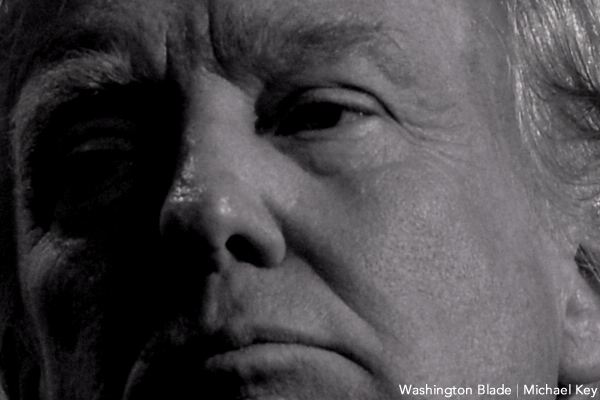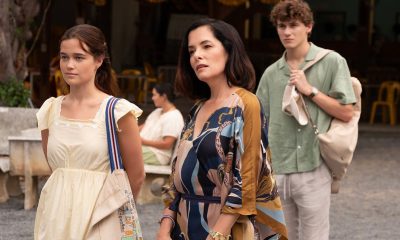Books
Trump to LGBT elders: DROP DEAD
Standing with our pioneers, #WeRefuseToBeInvisible


President Donald Trump (Washington Blade photo by Michael Key)
Four months into the Trump administration and it’s become clear that LGBT elders and their advocates are in for a big fight, with the new regime in Washington seemingly determined to erase the progress toward LGBT inclusion in federal aging policies and programs. Given the erasure of LGBT issues from White House and federal agency websites within hours of Donald Trump’s inauguration, we at SAGE were alarmed but not surprised when we learned of plans to eliminate LGBT elders from the annual survey that determines how $2 billion in publicly funded elder services gets distributed. This outrageous move sends a clear message to LGBT elders, many of whose very lives depend upon federally funded services, that the Trump administration doesn’t care whether they receive those services or not.
As the leading voice for LGBT elders nationally, SAGE responded quickly with the #WeRefuseToBeInvisible campaign – a grassroots effort to mobilize a strong response to the public comment period that the Trump administration is legally required to undertake before erasing an entire population from an important federal program. To date, SAGE’s campaign has resulted in more than 8,000 letters of opposition making their way to Washington.
Many organizations, LGBT and allies alike, have joined the cause. As Dr. Yanira Cruz, president and CEO of the National Hispanic Council on Aging, put it: “We know that Donald Trump and [Health & Human Services Cabinet Secretary] Tom Price won’t change their minds on their own, which is why we’re joining forces with SAGE to raise our voices in demanding that HHS add LGBT questions back into its survey of older adults…Because everyone, at every stage of life, deserves to be counted, heard, and treated with respect.”
A broad array of organizations – from national and local LGBT leaders like the Human Rights Campaign, the National LGBTQ Task Force and Fenway Community Health to aging sector leaders like Justice in Aging and the Leadership Council of Aging Organizations have mobilized their constituents to express opposition to the erasure of LGBT elders. A recent analysis published on Storify demonstrates the degree to which #WeWillNotBeInvisible has caught on via social media, touching a powerful nerve across LGBT communities and with allies.
There are emerging indications that at least some in Washington are listening. On April 27, a bi-partisan group of 19 U.S. senators led by Susan Collins, Republican chair of the Senate’s Special Committee on Aging, publicly demanded a reversal of the Trump administration’s plans to erase LGBT elders.
The deadline for the public comment period for the survey exclusion is May 12. SAGE and our many campaign partners will be generating opposition until the last possible moment. Unfortunately, there is every indication that, as the public comment period winds down and we await a final decision from the Trump administration on LGBT inclusion in the elder services survey, more battles are on the horizon.
The so-called “religious freedom” executive order signed by Donald Trump last week lays the groundwork for Attorney General Jeff Sessions, a long-time opponent of LGBT equality, to authorize religious-based discrimination across federally supported programs. Given the history of religion-based anti-LGBT teachings, and the fact that faith-based organizations make up more than 70 percent of the long-term care providers upon which older Americans are forced to rely, LGBT elders have every reason to be deeply concerned that they will pay a high price for the Trump administration’s determination to favor religious voices over all others. Tragically, discrimination far too often forces LGBT elders who need care and services back into “the closet” in order to protect themselves from mistreatment. We’ve made progress on that front in recent years, as SAGE has led efforts across the country to use training to improve treatment of LGBT elders by care providers. It will require extraordinary vigilance to ensure the administration’s drive to elevate religious voices – fueled by right-wing evangelical Trump supporters – does not erase that progress.
And the threats don’t stop there. On the very same day the “religious freedom” executive order was signed, the House of Representatives – in a party-line vote – succeeded in passing a slapped-together bill that would replace Obamacare with a disastrous approach to health care that favors the wealthy and dumps on everybody else. Among the many groups that would be hurt by Trumpcare, older people face the threat of health insurance premiums that are five times higher than premiums for younger people. Here again, we must fight as hard as possible to ensure that this terrible rollback in progress is stopped in its tracks.
Through all of these battles, and those to come, SAGE will continue to stand with and for our LGBT elder pioneers. We will not back down. We refuse to be invisible.
Michael Adams is CEO of SAGE.
Books
Two new books on dining out LGBTQ-style
Visit nightclubs, hamburger joints, and a bathhouse that feeds customers

‘What is Queer Food? How We Served a Revolution’
By John Birdsall
c.2025, W.W. Norton
$29.99/304 pages
‘Dining Out: First Dates, Defiant Nights, and Last Call Disco Fries at America’s Gay Restaurants’
By Erik Piepenburg
c.2025, Grand Central
$30/352 pages
You thought a long time about who sits where.
Compatibility is key for a good dinner party, so place cards were the first consideration; you have at least one left-hander on your guest list, and you figured his comfort into your seating chart. You want the conversation to flow, which is music to your ears. And you did a good job but, as you’ll see with these two great books on dining LGBTQ-style, it’s sometimes not who sits where, but whose recipes were used.
When you first pick up “What is Queer Food?” by John Birdsall, you might miss the subtitle: “How We Served a Revolution.” It’s that second part that’s important.

Starting with a basic gay and lesbian history of America, Birdsall shows how influential and (in)famous 20th century queer folk set aside the cruelty and discrimination they received, in order to live their lives. They couldn’t speak about those things, he says, but they “sat down together” and they ate.
That suggested “a queer common purpose,” says Birdsall. “This is how who we are, dahling, This is how we feed our own. This is how we stay alive.”
Readers who love to cook, bake or entertain, collect cookbooks, or use a fork will want this book. Its stories are nicely served, they’re addicting, and they may send you in search of cookbooks you didn’t know existed.
Sometimes, though, you don’t want to be stuck in the kitchen, you want someone else to bring the grub. “Dining Out” by Erik Piepenburg is an often-nostalgic, lively look at LGBTQ-friendly places to grab a meal – both now and in the past.

In his introduction, Piepenburg admits that he’s a journalist, “not a historian or an academic,” which colors this book, but not negatively. Indeed, his journeys to “gay restaurants” – even his generous and wide-ranging definitions of the term – happily influence how he presents his narrative about eateries and other establishments that have fed protesters, nourished budding romances, and offered audacious inclusion.
Here, there are modern tales of drag lunches and lesbian-friendly automats that offered “cheap food” nearly a century ago. You’ll visit nightclubs, hamburger joints, and a bathhouse that feeds customers on holidays. Stepping back, you’ll read about AIDS activism at gay-friendly establishments, and mostly gay neighborhood watering holes. Go underground at a basement bar; keep tripping and meet proprietors, managers, customers and performers. Then take a peek into the future, as Piepenburg sees it.
The locales profiled in “Dining Out” may surprise you because of where they can be found; some of the hot-spots practically beg for a road trip.
After reading this book, you’ll feel welcome at any of them.
If these books don’t shed enough light on queer food, then head to your favorite bookstore or library and ask for help finding more. The booksellers and librarians there will put cookbooks and history books directly in your hands, and they’ll help you find more on the history and culture of the food you eat. Grab them and you’ll agree, they’re pretty tasty reads.
The Blade may receive commissions from qualifying purchases made via this post.

You’re going to be on your feet a lot this month.
Marching in parades, dancing in the streets, standing up for people in your community. But you’re also likely to have some time to rest and reflect – and with these great new books, to read.
First, dip into a biography with “Marsha: The Joy and Defiance of Marsha P. Johnson” by Tourmaline (Tiny Rep Books, $30), a nice look at an icon who, rumor has it, threw the brick that started a revolution. It’s a lively tale about Marsha P. Johnson, her life, her activism before Stonewall and afterward. Reading this interesting and highly researched history is a great way to spend some time during Pride month.
For the reader who can’t live without music, try “The Dad Rock That Made Me a Woman” by Niko Stratis (University of Texas Press, $27.95), the story of being trans, searching for your place in the world, and finding it in a certain comfortable genre of music. Also look for “The Lonely Veteran’s Guide to Companionship” by Bronson Lemer (University of Wisconsin Press, $19.95), a collection of essays that make up a memoir of this and that, of being queer, basic training, teaching overseas, influential books, and life.
If you still have room for one more memoir, try “Walk Like a Girl” by Prabal Gurung (Viking, $32.00). It’s the story of one queer boy’s childhood in India and Nepal, and the intolerance he experienced as a child, which caused him to dream of New York and the life he imagined there. As you can imagine, dreams and reality collided but nonetheless, Gurung stayed, persevered, and eventually became an award-winning fashion designer, highly sought by fashion icons and lovers of haute couture. This is an inspiring tale that you shouldn’t miss.
No Pride celebration is complete without a history book or two.
In “Trans History: From Ancient Times to the Present Day” by Alex L. Combs & Andrew Eakett ($24.99, Candlewick Press), you’ll see that being trans is something that’s as old as humanity. One nice part about this book: it’s in graphic novel form, so it’s lighter to read but still informative. Lastly, try “So Many Stars: An Oral History of Trans, Nonbinary, Genderqueer, and Two-Spirit People of Color” by Caro De Robertis (Algonquin Books of Chapel Hill. $32.00) a collection of thoughts, observations, and truths from over a dozen people who share their stories. As an “oral history,” you’ll be glad to know that each page is full of mini-segments you can dip into anywhere, read from cover to cover, double-back and read again. It’s that kind of book.
And if these six books aren’t enough, if they don’t quite fit what you crave now, be sure to ask your favorite bookseller or librarian for help. There are literally tens of thousands of books that are perfect for Pride month and beyond. They’ll be able to determine what you’re looking for, and they’ll put it directly in your hands. So stand up. March. And then sit and read.
a&e features
James Baldwin bio shows how much of his life is revealed in his work
‘A Love Story’ is first major book on acclaimed author’s life in 30 years

‘Baldwin: A Love Story’
By Nicholas Boggs
c.2025, FSG
$35/704 pages
“Baldwin: A Love Story” is a sympathetic biography, the first major one in 30 years, of acclaimed Black gay writer James Baldwin. Drawing on Baldwin’s fiction, essays, and letters, Nicolas Boggs, a white writer who rediscovered and co-edited a new edition of a long-lost Baldwin book, explores Baldwin’s life and work through focusing on his lovers, mentors, and inspirations.
The book begins with a quick look at Baldwin’s childhood in Harlem, and his difficult relationship with his religious, angry stepfather. Baldwin’s experience with Orilla Miller, a white teacher who encouraged the boy’s writing and took him to plays and movies, even against his father’s wishes, helped shape his life and tempered his feelings toward white people. When Baldwin later joined a church and became a child preacher, though, he felt conflicted between academic success and religious demands, even denouncing Miller at one point. In a fascinating late essay, Baldwin also described his teenage sexual relationship with a mobster, who showed him off in public.
Baldwin’s romantic life was complicated, as he preferred men who were not outwardly gay. Indeed, many would marry women and have children while also involved with Baldwin. Still, they would often remain friends and enabled Baldwin’s work. Lucien Happersberger, who met Baldwin while both were living in Paris, sent him to a Swiss village, where he wrote his first novel, “Go Tell It on the Mountain,” as well as an essay, “Stranger in the Village,” about the oddness of being the first Black person many villagers had ever seen. Baldwin met Turkish actor Engin Cezzar in New York at the Actors’ Studio; Baldwin later spent time in Istanbul with Cezzar and his wife, finishing “Another Country” and directing a controversial play about Turkish prisoners that depicted sexuality and gender.
Baldwin collaborated with French artist Yoran Cazac on a children’s book, which later vanished. Boggs writes of his excitement about coming across this book while a student at Yale and how he later interviewed Cazac and his wife while also republishing the book. Baldwin also had many tumultuous sexual relationships with young men whom he tried to mentor and shape, most of which led to drama and despair.
The book carefully examines Baldwin’s development as a writer. “Go Tell It on the Mountain” draws heavily on his early life, giving subtle signs of the main character John’s sexuality, while “Giovanni’s Room” bravely and openly shows a homosexual relationship, highly controversial at the time. “If Beale Street Could Talk” features a woman as its main character and narrator, the first time Baldwin wrote fully through a woman’s perspective. His essays feel deeply personal, even if they do not reveal everything; Lucian is the unnamed visiting friend in one who the police briefly detained along with Baldwin. He found New York too distracting to write, spending his time there with friends and family or on business. He was close friends with modernist painter Beauford Delaney, also gay, who helped Baldwin see that a Black man could thrive as an artist. Delaney would later move to France, staying near Baldwin’s home.
An epilogue has Boggs writing about encountering Baldwin’s work as one of the few white students in a majority-Black school. It helpfully reminds us that Baldwin connects to all who feel different, no matter their race, sexuality, gender, or class. A well-written, easy-flowing biography, with many excerpts from Baldwin’s writing, it shows how much of his life is revealed in his work. Let’s hope it encourages reading the work, either again or for the first time.
-

 U.S. Supreme Court5 days ago
U.S. Supreme Court5 days agoSupreme Court upholds ACA rule that makes PrEP, other preventative care free
-

 U.S. Supreme Court5 days ago
U.S. Supreme Court5 days agoSupreme Court rules parents must have option to opt children out of LGBTQ-specific lessons
-

 Television5 days ago
Television5 days ago‘White Lotus,’ ‘Severance,’ ‘Andor’ lead Dorian TV Awards noms
-

 Music & Concerts5 days ago
Music & Concerts5 days agoBerkshire Choral to commemorate Matthew Shepard’s life









